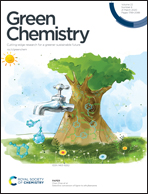Microalgae: a sustainable adsorbent with high potential for upconcentration of indium(iii) from liquid process and waste streams†
Abstract
Indium (In) is a critical raw material in heavy demand in the optical-electronics industry. With its high supply risk, sustainable technologies are needed to recover In(III) from secondary sources, such as leachates from sludge produced by zinc processing industries (e.g., jarosite) and indium tin oxide etching wastewater. This study presents In(III) biosorption as an eco-friendly alternative to conventional physicochemical recovery technologies. The characteristics of In(III) adsorption by microalgal biomass were investigated in batch experiments. Adsorption isotherms were well-fitted by the Freundlich model. The estimated maximum In(III) adsorption capacity of microalgae was 0.14 mmol g−1, which is higher than that of some chemically modified adsorbents reported in the literature. Selectivity for In(III) was also observed over other metals, such as Cu(II), Zn(II), and Al(III). Furthermore, the microalgae biosorbent was regenerated using 0.1 M HCl solution, with up to 80% In(III) recovery, for several cycles. From these results, microalgae prove to have potential for In(III) biosorption from aqueous solution.



 Please wait while we load your content...
Please wait while we load your content...